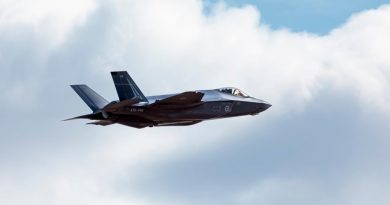Action above, on and below the sea

Cooperation was heightened, skills strengthened and relationships deepened as Exercise Malabar drew together Australian, Japanese, Indian and United States forces for high-end warfighting training.
CAPTION: Leading Seaman Nathan Cox watches out of HMAS Arunta’s embarked MH-60R helicopter “Athena” as HMAS Arunta (right) and USS Milius conduct a duel Replenishment at Sea with JS Oumi during Exercise Malabar 2022. Story by Lieutenant Commanders Victor Yee and Andrew Herring. Photo by Leading Seaman Susan Mossop.
The Royal Australian Navy Anzac-class frigate HMAS Arunta represented Australia, along with the auxiliary oiler HMAS Stalwart, Collins-class submarine HMAS Farncomb and a Royal Australian Air Force P-8A Poseidon maritime patrol aircraft.
The 26th iteration of the annual exercise, conducted off the coast of Japan in November, was the third time all four nations had participated together.
Exercise Malabar included the full spectrum of maritime operations from joint planning, communications and replenishments at sea, through to anti-air, anti-surface and anti-submarine warfare.

CAPTION:HMAS Arunta, right, conducts a replenishment at sea with JS Oumi, centre, as INS Kamorta sails into formation. Photo by Leading Seaman Susan Mossop.
Arunta operated as part of a surface action group with Japan Maritime Self-Defense Force (JMSDF) destroyer JS Hyuga and auxiliary oiler JS Oumi, Indian Navy Kamorta-class anti-submarine stealth frigate INS Kamorta, US Navy Arleigh Burke-class guided missile destroyer USS Milius and Nimitz-class aircraft carrier USS Ronald Reagan.
The exercise saw Arunta’s MH-60R helicopter Athena defend the ship against sub-surface threats by hunting Farncomb and a JMSDF submarine.
The rest of Arunta’s crew tested their skills and systems by defending against threats from above, engaging airborne targets in combined anti-air exercises.
Maritime skills were also enhanced with a dual replenishment at sea, which saw Arunta and Milius simultaneously receive fuel from Oumi while underway, as Kamorta waited astern for its turn to refuel.
Understanding between participating forces was also improved through cross-decking opportunities and integrated operations.
Athena landed on Ronald Reagan and Hyuga, while Arunta’s crew experienced carrier operations when Arunta served as the aircraft carrier’s horizon reference unit and plane guard.

CAPTION: From front, JS Takanami, USS Milius and INS Kamorta conduct a 5-inch naval gun shoot. Photo by Leading Seaman Susan Mossop.
Arunta also hosted an Indian Navy lieutenant, who spent a week embedded on board as part of Arunta’s ships company.
The exercise culminated in a ‘War at sea’ day where all participants put to use what they had practised.
The activity allowed the four partner navies to enhance mutual understanding while practising high-end warfighting.
Arunta Commanding Officer Commander Jason McBain said the exercise was a great opportunity to work with partner nations to improve interoperability and demonstrate Australia’s commitment to the Indo-Pacific region.
“Malabar allows us to work closely with our regional partners in support of an open, secure and prosperous region,” Commander McBain said.
“It’s also great to build upon the skills and relationships developed with Japan, India, and the United States during Exercise Milan earlier this year.”
Leading Seaman Aircrew Nathan Cox said the exercise was also beneficial experience for the Athena team.
“Exercise Malabar was a great opportunity to get airborne and interact with all members of the group,” he said.
“Malabar has highlighted a strong level of interoperability and cohesion.”

CAPTION: JS Oumi, centre, conducts a dual replenishment at sea with HMAS Arunta, left, and USS Milius. Photo by Leading Seaman Susan Mossop.
.
.

.
.





